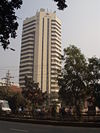Portal:Bangladesh
2008/9 Schools Wikipedia Selection. Related subjects: Asia; Asian Cities; Portals
|
Portal:Bangladesh
Bangladesh, officially the People's Republic of Bangladesh, is a country in South Asia. It is bordered by India on three sides and Myanmar to the southeast; the Bay of Bengal forms the southern coastline. Together with the Indian state of West Bengal, it comprises the ethno-linguistic region of Bengal. The name Bangladesh means "Country of Bengal" and is written as বাংলাদেশ and pronounced IPA: ['baŋlad̪eʃ]. The exact origin of the word Bangla or Bengal is unknown. The borders of Bangladesh were set by the Partition of India in 1947, when it became the eastern wing of Pakistan (East Pakistan), separated from the western wing by 1,600 km (1,000 miles). Despite their common religion, the ethnic and linguistic gulf between the two wings was compounded by an apathetic government based in West Pakistan. This resulted in the independence of Bangladesh in 1971 after a bloody war, supported by India. The years following independence have been marked by political turmoil, with thirteen different heads of government, and at least four military coups. The population of Bangladesh ranks seventh in the world, but its area of approximately 144,000 sq km is ranked ninety-third. It is the third largest Muslim-majority nation, but has a slightly smaller Muslim population than the Muslim minority in India. It is also one of the most densely populated countries in the world. Geographically dominated by the fertile Ganges-Brahmaputra Delta, the country has annual monsoon floods, and cyclones are frequent. Bangladesh is one of the founding members of South Asian Association for Regional Cooperation (SAARC), BIMSTEC, and a member of the OIC and the D-8.
Selected article
The Grameen Bank (Bangla: গ্রামীণ ব্যাংক) is a microfinance organization started in Bangladesh that makes small loans (known as microcredit) to the impoverished without requiring collateral. The system is based on the idea that the poor have skills that are under-utilized. The bank also accepts deposits, provides other services, and runs several development-oriented businesses including fabric, telephone and energy companies. The organization and its founder, Muhammad Yunus, were jointly awarded the Nobel Peace Prize in 2006. Muhammad Yunus, the bank's founder, earned a doctorate in economics from Vanderbilt University in the United States. He was inspired during the terrible Bangladesh famine of 1974 to make a small loan of $27 to a group of 42 families so that they could create small items for sale without the burdens of predatory lending. The Grameen Bank (literally, "Bank of the Villages", in Bangla) is the outgrowth of Muhammad Yunus' ideas. The bank began as a research project by Yunus and the Rural Economics Project at Bangladesh's University of Chittagong to test his method for providing credit and banking services to the rural poor. In 1976, the village of Jobra and other villages surrounding the University of Chittagong became the first areas eligible for service from Grameen Bank. The Bank was immensely successful and the project, with government support, was introduced in 1979 to the Tangail District (to the north of the capital, Dhaka). The bank's success continued and it soon spread to various other districts of Bangladesh and in 1983 it was transformed into an independent bank by the legislature of Bangladesh. Bankers from ShoreBank, a community development bank in Chicago, helped Yunus with the official incorporation of the bank under a grant from the Ford Foundation. The bank's repayment rate was hit following the 1998 flood of Bangladesh before recovering again in recent years. The Bank today continues to expand across the nation and still provides small loans to the rural poor. As of mid- 2006, Grameen Bank branches number over 2,100. Its success has inspired similar projects around the world. ( more...) |
Where in Bangladesh...
Selected picture
|
Did you know...
Selected biography
Emperor Humayun (full title: Al-Sultan al-'Azam wal Khaqan al-Mukarram, Jam-i-Sultanat-i-haqiqi wa Majazi, Sayyid al-Salatin, Abu'l Muzaffar Nasir ud-din Muhammad Humayun Padshah Ghazi, Zillu'llah) ( 17 March 1508 – 4 March 1556) ( OS 7 March 1508- OS 22 February 1556) was the second Mughal Emperor who ruled modern Afghanistan, Pakistan, and parts of northern India from 1530–1540 and again from 1555–1556. Like his father, Babur, he lost his kingdom early, but with Persian aid, he eventually regained an even larger one. On the eve of his death in 1556, the Mughal empire spanned almost 250 million acres. He succeeded his father in India in 1530, while his half-brother Kamran Mirza, who was to become a rather bitter rival, obtained the sovereignty of Kabul and Lahore, the more northern parts of their father's empire. He originally ascended the throne at the age of 22 and was somewhat inexperienced when he came to power. Humayun lost his Indian territories to the Afghan Sultan, Sher Shah Suri, and, with Persian aid, regained them fifteen years later. Humayun's return from Persia, accompanied by a large retinue of Persian noblemen, signalled an important change in Mughal Court culture, as the Central Asian origins of the dynasty were largely overshadowed by the influences of Persian art, architecture, language and literature. Subsequently, in a very short time, Humayun was able to expand the Empire further, leaving a substantial legacy for his son, Akbar the Great (Akbar-e-Azam). ( more) |
|
|||||||||||||||||







